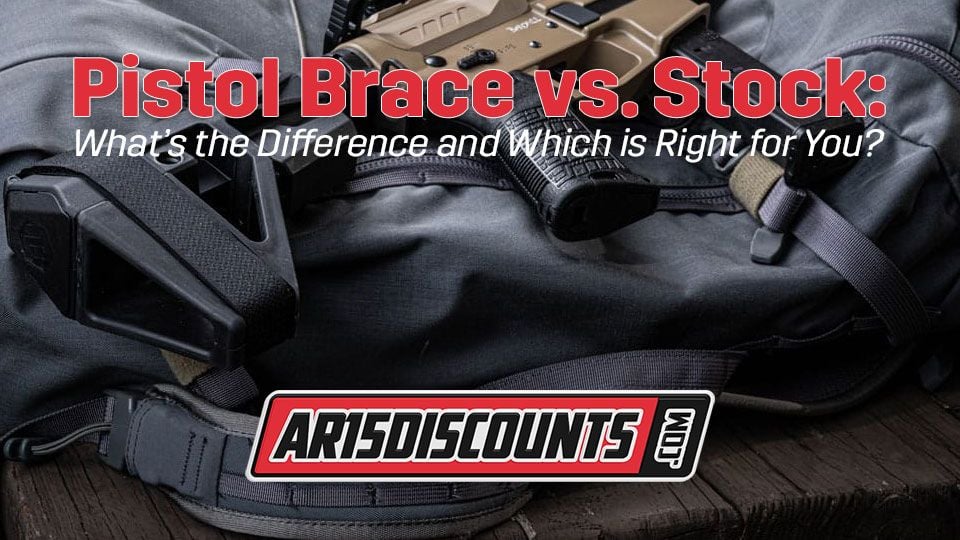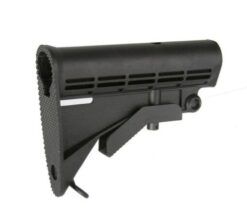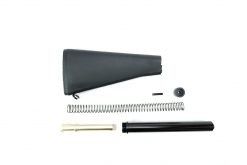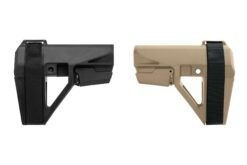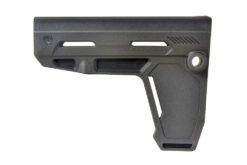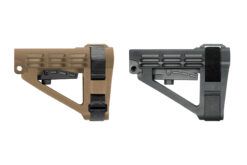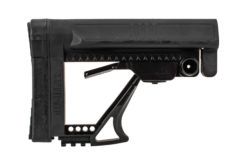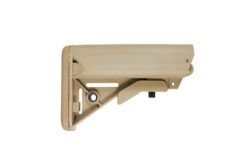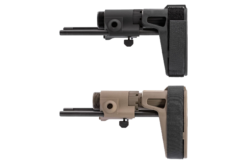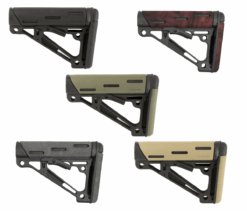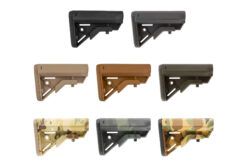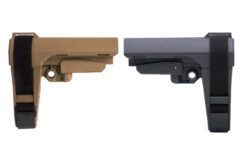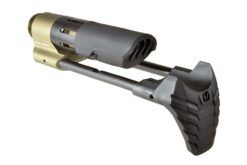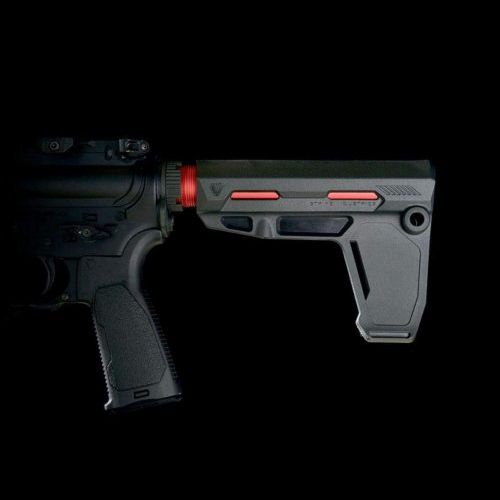AR-15 Accessories, AR-15 Parts
Pistol Brace vs. Stock: What’s the Difference and Which is Right for You?
Table of contents
- Defining Pistol Braces and Stocks
- Key Differences Between a Pistol Brace and a Stock
- Legal Considerations (2024 Update)
- Performance & Handling Differences
- Use Cases & Best Applications
- Which One Should You Choose?
- Frequently Asked Questions (FAQs)
- Find the Best Pistol Braces and AR-15 Stocks for Your Build
They serve distinct purposes in firearm customization. Pistol braces provide additional stability for shooters using a firearm with one hand, while an AR-15 stock is meant for shouldering, offering improved control and accuracy. These components enhance a firearm’s usability, whether for home defense, tactical applications, or recreational shooting.
However, choosing between a pistol brace and a stock isn’t just about performance—it’s also a legal consideration. ATF regulations surrounding pistol braces have changed over the years, affecting how these accessories are classified and used. Understanding these rules is essential for compliance, particularly when modifying AR-15 and AK pistols.
In this guide, we’ll break down the key differences between pistol braces and stocks, explore their advantages, and discuss how recent ATF pistol brace regulations will impact firearm owners in 2024. Whether you’re looking for improved stability, better control, or legal flexibility, knowing which option suits your needs will help you make an informed decision.
Defining Pistol Braces and Stocks
Understanding the difference between a pistol brace and a stock is essential when customizing a firearm. While both attachments enhance stability and control, their design, function, and legal classification vary significantly. A pistol brace is intended for use on large-format pistols, offering support without reclassifying the firearm as a rifle. In contrast, a stock is designed for shouldering, improving accuracy but often requiring compliance with NFA regulations. Below, we’ll break down the purpose, common types, and key distinctions between these two components.
What is a Pistol Brace?
A pistol brace is a firearm accessory designed to enhance stability and control, particularly for AR-15 and AK pistols. Originally developed to help disabled shooters fire large-format pistols with one hand, pistol braces attach to the rear of a firearm and rest against the shooter’s forearm for improved support. This design allows users to maintain better control and accuracy while keeping the gun classified as a pistol under federal law—provided it adheres to ATF regulations.
There are several types of pistol braces, each offering different mounting solutions and configurations:
- Picatinny pistol braces – Attach to firearms with a Picatinny rail system for a secure, modular setup.
- Folding pistol braces – Feature a hinge mechanism for compact storage and portability.
- Glock pistol braces – Specifically designed for Glock-style pistols, offering improved ergonomics and stability.
What is a Stock?
A stock is a traditional firearm component designed to be shouldered, providing enhanced control, recoil mitigation, and long-range accuracy. Unlike pistol braces, stocks are classified as rifle accessories and, when attached to a firearm with a barrel shorter than 16 inches, reclassify it as a Short-Barreled Rifle (SBR), requiring registration under the National Firearms Act (NFA).
Stocks are ideal for shooters prioritizing precision, stability, and a comfortable shouldering position. They are commonly used on full-sized rifles and SBRs for enhanced tactical, hunting, and competition performance.
Key Differences Between a Pistol Brace and a Stock
Choosing between a pistol brace and a stock comes down to function, legality, and intended use. While both attachments provide enhanced firearm control, a pistol brace is designed for stabilization and compliance with pistol classification laws, whereas a stock is meant for shouldering. Both offer greater accuracy but often require NFA registration if used on a short-barreled firearm.
To better understand the distinctions, here’s a side-by-side comparison:
| Feature | Pistol Brace | Stock |
|---|---|---|
| Primary Purpose | Stabilization for one-handed shooting | Shoulder support for improved accuracy |
| Legality (2024 Update) | Subject to ATF regulations; may require compliance updates | Requires NFA registration if used on a short-barreled firearm |
| Stability & Control | Provides moderate recoil control | Offers maximum recoil mitigation and stability |
| Adjustability | Some models offer folding or collapsible options | Typically adjustable for length of pull and ergonomics |
| Weight | Lightweight, designed for maneuverability | Heavier for increased control and precision |
| NFA Regulations | Legal when compliant with ATF rulings | Requires tax stamp if used on an SBR |
| Best For | CQB, home defense, states with strict SBR laws | Long-range precision, tactical duty use, competitive shooting |
Understanding these key differences ensures firearm owners can choose the right option for their needs while staying compliant with current regulations.
Legal Considerations (2024 Update)
. Over the past few years, ATF regulations regarding pistol braces have shifted, creating uncertainty for firearm owners. However, as of June 13, 2024, a federal judge in Texas ruled the ATF’s pistol brace ban invalid in the case of Mock v. Garland, meaning pistol braces remain legal. Firearm owners should stay informed about potential legal changes despite this ruling.
Pistol Braces & ATF Rule Changes
The ATF’s pistol brace rule, initially introduced in 2023, attempted to reclassify firearms equipped with pistol braces as Short-Barreled Rifles (SBRs), subjecting them to NFA (National Firearms Act) regulations. This ruling affected popular models, including the AR-15, AK, and Glock pistol brace. However, the June 2024 court decision overturned this restriction, ensuring that firearm owners can legally possess and use pistol braces without additional registration.
Stocks & NFA Compliance
Unlike pistol braces, a stock is classified as a rifle component. If a stock is attached to a firearm with a barrel shorter than 16 inches, the gun becomes an SBR, requiring registration with the ATF under the NFA. This process includes:
- Submitting ATF Form 1
- Paying a $200 tax stamp
- Undergoing a background check and waiting period
Failure to comply with SBR regulations can lead to severe legal consequences, including fines and penalties.
What’s the Best Legal Option for You?
For firearm owners who want maximum legal flexibility, pistol braces remain the best option, especially in states with strict SBR laws. They offer enhanced stability without requiring NFA registration. However.
Regardless of your choice, staying informed about ATF regulations and state laws is essential to ensure full compliance while optimizing your firearm’s performance.
Performance & Handling Differences
. While both accessories offer improved control, they differ in how they manage recoil, enhance accuracy, and affect comfort during shooting.
Recoil Management
- Pistol Brace: Designed to stabilize a firearm when fired with one hand or with minimal shoulder contact. While it helps mitigate recoil somewhat, it does not provide the same level of control as a stock due to its lightweight design and lack of full shoulder support.
- Stock: Absorbs recoil more effectively since it is meant to be firmly shouldered. This results in better overall control, particularly for rapid follow-up shots and sustained fire. Stocks are the preferred choice for shooters prioritizing recoil reduction.
Accuracy & Stability
- Pistol Brace: This brace offers moderate stability and helps improve short-range accuracy in CQB (Close Quarters Battle) scenarios. However, since it is not meant to be entirely shouldered, it does not provide the same precision as a stock for long-range shooting.
- Stock: Provides a more stable shooting platform, significantly improving accuracy at medium to long distances. With better weight distribution and firm shouldering, it allows for precise shot placement, making it ideal for precision shooting and tactical applications.
Comfort & Ergonomics
- Pistol Brace: Typically more compact and lightweight, making it comfortable for home defense, EDC-style builds, and maneuverability in tight spaces. However, some models may feel less secure when shouldered than a stock.
- Stock: Designed for optimal ergonomics, stocks often include adjustable length-of-pull, cheek rests, and recoil-absorbing materials. These features make them more comfortable for extended shooting sessions and high-volume firing scenarios.
Final Thoughts on Performance
If you prioritize mobility, legal flexibility, and lightweight handling, a pistol brace is a solid choice. However, for superior accuracy, recoil control, and all-day shooting comfort, a stock offers undeniable advantages—provided you’re willing to comply with NFA regulations for an SBR setup.
Use Cases & Best Applications
The choice between a pistol brace and a stock depends on how you intend to use your firearm. While both options enhance control, they excel in different scenarios. Below are the best applications for a pistol brace.
Pistol Brace Best For:
Home Defense & CQB (Close Quarters Battle)
A pistol brace is well-suited for home defense and CQB situations where compactness and maneuverability are essential. Its lightweight design allows easy handling in confined spaces like hallways and doorways, making it easier to engage threats while maintaining control quickly.
Legal Flexibility in States with Strict SBR Laws
. A pistol brace provides a legal workaround, allowing firearm owners to maintain a short-barreled setup without the complexities of SBR compliance.
Lightweight Builds for Easy Handling
For those looking for a lightweight firearm, whether for truck guns, backpack setups, or quick deployment, a pistol brace is an excellent option. It reduces overall weight compared
If compact size, legal flexibility, and ease of handling are priorities, a pistol brace is the best choice.
Which One Should You Choose?
Deciding between a pistol brace and a stock depends on personal preference, intended use, and legal considerations. While both options offer stability and control, each serves different needs and has its own set of regulations.
Personal Preference vs. Legal Restrictions
If you want a compact and maneuverable firearm without dealing wrm setup while staying compliant with current ATF rulings. Since the Mock v. Garland decision in June 2024 ruled the ATF’s pistol brace ban invalid, braces remain legal for use without requiring registration.
On the other hand, if you prioritize maximum recoil control, accuracy, and comfort for extended shooting, a stock is the superior option. However, attaching a stock to a firearm with a barrel shorter than 16 inches reclassifies it as an SBR, requiring an NFA tax stamp and registration.
Recommendations Based on Intended Firearm Use
- Choose a Pistol Brace If:
- You need a compact firearm for home defense or CQB.
- You want legal flexibility without registering an SBR.
- You prefer a lightweight setup for easy maneuverability.
- Choose a Stock If:
- You require maximum stability and recoil control.
- You are using the firearm for long-range precision shooting.
- You don’t mind going through NFA registration for an SBR.
Ifif legal flexibility and portability are your priorities, a pistol brace is the better choice. However, if long-range accuracy and recoil management are more critical, and you are willing to register an SBR, a stock will perform best.
Frequently Asked Questions (FAQs)
Choosing between a pistol brace and a stock involves understanding their differences, legal implications, and best applications. Below, we answer some of the most common questions to help you make an informed decision.
1. Is a pistol brace legal in 2025?
Yes, as of June 13, 2024, pistol braces remain legal following a federal court ruling in Mock v. Garland, invalidating the ATF’s pistol brace ban. Before this ruling, the ATF attempted to classify braced pistols as Short-Barreled Rifles (SBRs), requiring NFA registration. However, this decision means firearm owners can legally own and use pistol braces without registering them as SBRs.
2. Can I shoulder a pistol brace?
Yes, current ATF regulations do not prohibit shouldering a pistol brace. While braces were initially designed to be strapped to the shooter’s forearm, the ATF has clarified in previous rulings that incidental or occasional shouldering of a pistol brace does not automatically reclassify the firearm as an SBR. However, legal interpretations can change, so staying updated on ATF rulings is essential.
3. Can I put a stock on my AR pistol?
No, attaching a stock to an AR pistol effectively converts it into a rifle. If the firearm has a barrel shorter than 16 inches, it is then classified as a Short-Barreled Rifle (SBR) under the National Firearms Act (NFA), requiring a $200 tax stamp and ATF Form 1 registration. If you do not register the firearm, it becomes an illegal unregistered SBR, which carries severe legal penalties.
4. Do I need a tax stamp for a pistol brace?
No, you do not need a tax stamp to own or use a pistol brace. Unlike stocks requiring NFA registration when used on a firearm with a barrel shorter than 16 inches, a pistol brace does not change the firearm’s legal classification.le changes are essential to ensure compliance.
5. What are the best pistol braces on the market?
Some of the top pistol braces available include:
- SB Tactical SBA3 – Adjustable and lightweight, widely used for AR and AK pistols.
- Gear Head Works Tailhook Mod 2 – Features a rigid design with an integrated adjustable mechanism.
- Strike Industries MPX/MCX Brace – Offers a folding design for compact storage.
- Midwest Industries Picatinny Pistol Brace – Designed for Picatinny rail mounting, providing a secure fit for various platforms.
Each brace has different advantages, so selecting one depends on your specific firearm platform, intended use, and comfort preferences.
6. How does a pistol brace affect firearm performance?
A pistol brace improves stability, recoil control, and accuracy, particularly for short-range shooting and home defense. While it does not provide the same level of shoulder support as a stock, it enhances handling by allowing shooters to maintain better control over their firearm. Many braces are adjustable and lightweight, making them ideal for CQB and mobile applications.
7. Is a pistol brace better than a stock?
It depends on your needs. A pistol brace is better if you:
- Want to maintain legal flexibility without dealing with NFA registration.
- Need a lightweight, compact firearm for home defense or CQB.
- Prefer a simpler, legal alternative to an SBR.
A stock is better if you:
- Prioritize recoil control, accuracy, and stability for long-range shooting.
- Are willing to register your firearm as an SBR under the NFA.
- Need a more ergonomic setup for extended shooting sessions.
8. Will ATF laws on pistol braces change again?
While the Mock v. Garland decision struck down the ATF’s pistol brace ban, future legal challenges or regulatory changes could arise. The ATF has a history of revising firearm classifications, and legislative actions could attempt to reinstate restrictions. Firearm owners should stay informed through trusted sources like the ATF website, firearm advocacy groups, and legal updates to ensure continued compliance.
Find the Best Pistol Braces and AR-15 Stocks for Your Build
Whether you’re looking for a pistol brace to enhance maneuverability or an AR-15 stock for improved stability and precision, choosing the right accessory is essential for optimizing your firearm. A pistol brace provides legal flexibility and lightweight control, making it perfect for home defense and CQB applications. At the same time, an AR-15 stock delivers superior recoil management and accuracy for long-range shooting and tactical use.
Explore a wide selection of top-quality pistol braces and stocks from leading brands, ensuring durability, performance, and compliance with current regulations. With the right upgrade, you can fine-tune your rifle or pistol to match your needs. Shop now and get the best components to complete your build!
For additional resources, www.arbuildjunkie.com

